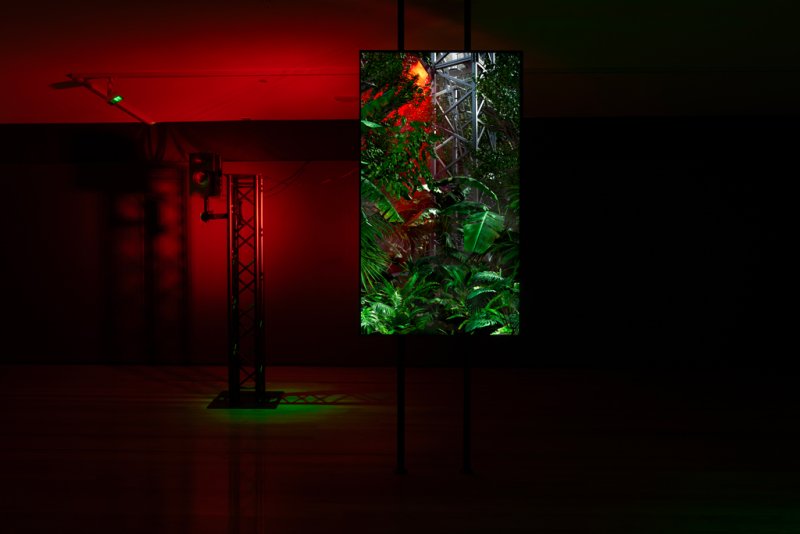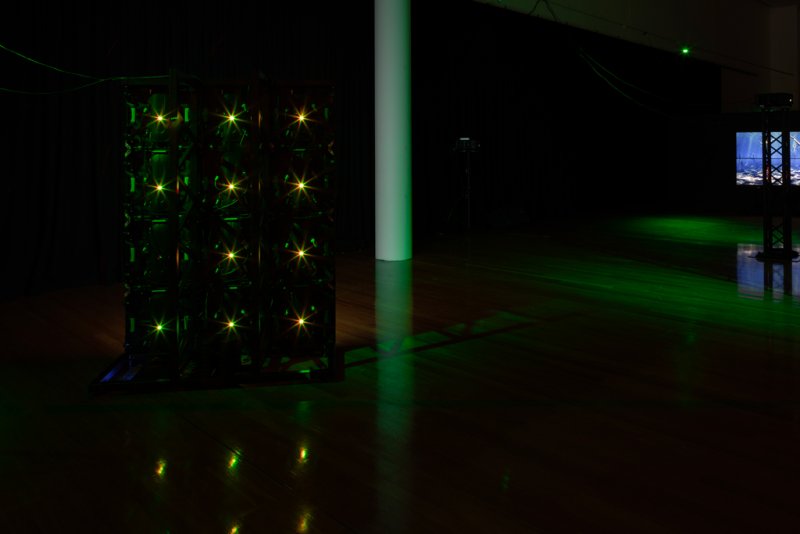The Mirror
EditorialAboutA+a Study CentreA+a ArchiveShopClose Menu

In September 2022, Australian multimedia artist Yandell Walton was one of thirteen participating artists in LABVERDE, an art immersion program based in the Amazon rainforest. Conducted in collaboration with Brazil’s National Institute of Amazonian Research and the Chico Mendes Institute for Biodiversity Conservation, LABVERDE’s 2022 Speculative Ecologies program brought together artists, Indigenous people, ecologists and scientists with the aim of encouraging and supporting the development of environment-related artistic languages. Through the sharing of cross-disciplinary knowledge and expertise and mutual experiences in the rainforest, LABVERDE hopes to generate ‘new ways of existence and interaction with environment’ and ‘co-imagine new approaches to current ecosystems’. As the program asks, ‘How can art develop strategies for the expansion of environmental justice?’1


Yandell Walton’s practice has long been concerned with the creation of immersive environments that convey the rapidly escalating crisis of environmental degradation and climate change on a physical and emotional register, so her inclusion in LABVERDE was both astute and meaningful. The result of this transformative experience is her exhibition Dissonant Terrain, currently on show at Wagga Wagga Art Gallery as part of GREEN 2023—a year of environmental exhibitions and programs delivered by the Gallery. Bringing five works together in concert to transform the gallery space and visitor experience, Dissonant Terrain draws upon concepts of the post-human and post-natural world to highlight the complex relationship between nature and technology and the devastating impact of human activity (and its various motivations) on the natural environment. After being enveloped in the carefully balanced ecosystem of the Amazon, Walton’s clarion call is the creation of a “natural” world that is subtly and unsettlingly askew—one that makes us feel as if we are balanced on a knife edge. As Emanuele Coccia has observed,
...A forest, and especially the Amazonian forest, is the quintessential form of inter-species coexistence. It is not simply an example of biodiversity, but the embodiment of an incalculable and unpredictable degree of richness and multiplicity of species belonging to the most disparate kingdoms. These forms do not simply coexist alongside each other, concentrated in a relatively small space: rather, they seem to live within each other, through each other, in a kind of mutual interpenetration that makes each body one of the infinite prostheses of another closely living being. In a forest, especially in the Amazonian rainforest, the inert matter of our planet is thus transformed into a psychedelic exercise of evoking forms, somewhere between dreaming and waking.2

The sense of ‘mutual interpenetration’ that Coccia discusses is at the heart of Dissonant Terrain, as Walton’s five works come together to create a digital forest ecosystem which is strange, otherworldly, and somehow at risk. Pulses of light within the videos and across the exhibition space are employed as a visual metaphor to signal and register alarm, just as different aspects of the technology used to drive and power the works (such as power cords) are lit by an eerie green light which calls attention to the ever-present and invasive role of technology and its often-unacknowledged environmental impact. Indeed, as one enters the exhibition space, the back of the video screen of Multi-species-convergence greets the viewer, its LED components blinking red and green in their own form of communication. On moving to the front of the work, the sense of interconnection is made complete as we witness a 3D-modeled plant (“built” by Walton through photogrammetry from hundreds of photographs of plants taken in the forest) come to life through the movement of a stylised “human” figure. Where one species starts and the other ends is no longer relevant—human, nature and technology have become one.
Walton’s intentions in Multi-species-convergence may initially seem unclear, but when viewed alongside the visuals of Flooded Forest—which responds to the devastating environmental impact of the creation of the Balbina Dam between 1985 and 1989 (which submerged nearly 3,000 square kilometres of the Amazon Forest, resulting in the displacement of the Waimiri-Atroari people and the emission of high levels of greenhouse gases)—perspectives crystallise. Walton visited the flooded forest during her LABVERDE residency, describing it as a ‘technological choice’ that left the landscape ‘like a graveyard of trees’.3
The artist’s CO2 Shower by contrast, is inspired by the ambition of a field experiment that she was introduced to at LABVERDE that is assessing the impact of high concentrations of carbon dioxide on the Amazonian rainforest in an attempt to better understand and future-proof its impact. In response to this speculative and hope-filled use of technology. CO2 Shower presents a digital forest that is evocatively and mysteriously filled with mist. The poetry of the work’s imagery, however, is undercut by the monumental presence of a large metal tower hovering within the tree canopy, and by the work’s unexpected and disturbing soundtrack—an alarm synchronised to sound in time with the flashing, coloured lights that appear intermittently within the landscape, before spilling into the gallery. Our ingrained physiological response to the alarm immediately heightens one’s senses as we brace ourselves for threats unseen and unknown.
Sound plays an important role in the darkened, atmospheric space of Dissonant Terrain. Walton engaged fellow LABVERDE artist Jana Irmert to compose the soundscape, which uses ‘radically slowed down’ field recordings of the night and daytime ambiences of the rainforest. As a result, our usual expectations of sound and its connection to various creatures is turned upon its head—high-pitched insect sounds for example, are transformed into low, ominous drones, and the ultrasonic vocalisation of bats, by being pitched down several octaves, can now be heard. While Irmert’s manipulations were in part a response to Walton’s visuals and their shared desire to create something ‘darker, not quite naturalistic’, they are equally a meditation on the possibilities of cross-species communication. As she explains,
… after experiencing the richness of the soundscape in the rainforest, I started wondering how other animals that communicate on a different frequency range, are perceiving that same soundscape. The forest must sound very different to bats or amphibians. So playing with the pitch and density of the soundscape became also a way to imagine that.4

In the end, Dissonant Terrain provides no answers, but that is also not its point. Its power is in the sense of immersion, and immediacy, that the installation creates, and in its ability to make environmental fragility and destruction feel palpable and urgent. As we stand before Being and see ourselves reflected back onto (and into) the work’s forest imagery, we realise that this is no longer something we simply read about or see on TV—we are in it and are part of it. Dissonant Terrain is a poignant call to action. We are all responsible for the future of this planet, and we need to act now.
1. Art Immersion Program in the Amazon: LABVERDE 2022, https://www.labverde.com/_files/ugd/7ea7d9_7fa1eafe394f4b989ef41768d7e33eb6.pdf?lang=en
2. Emanuele Coccia, “Sensitive Amazonia” in Art Immersion Program in the Amazon: LABVERDE 2022, p. 20.
3. Conversation with the author, 11 September 2023. “As a result of the methane released from its vast reservoir, proportional to its output, the Balbina Dam emits ten times more greenhouse gases than a coal plant. The dam is the least efficient in Brazil in terms of the area flooded for each megawatt generated.”, https://en.wikipedia.org/wiki/Balbina_Dam
4. Jana Irmert email correspondence with Yandell Walton (excerpt), n.d., provided by the artist.
Author/s: Kelly Gellatly
Yandell Walton: Dissonant Terrain, Wagga Wagga Art Gallery, 19 August – 26 November 2023
Yandell Walton’s Dissonant Terrain was commissioned by Wagga Wagga Art Gallery with the support of Create NSW.
Kelly Gellatly. 2023. “Yandell Walton: Dissonant Terrain.” Art and Australia 58, no.2 https://artandaustralia.com/58_2/p169/yandell-walton-dissonant-terrain
Art + Australia Editor-in-Chief: Su Baker Contact: info@artandaustralia.com Receive news from Art + Australia Art + Australia was established in 1963 by Sam Ure-Smith and in 2015 was donated to the Victorian College of the Arts at the University of Melbourne by then publisher and editor Eleonora Triguboff as a gift of the ARTAND Foundation. Art + Australia acknowledges the generous support of the Dr Harold Schenberg Bequest and the Centre of Visual Art, University of Melbourne. @Copyright 2022 Victorian College of the Arts The views expressed in Art + Australia are those of the contributing authors and not necessarily those of the editors or publisher. Art + Australia respects your privacy. Read our Privacy Statement. Art + Australia acknowledges that we live and work on the unceded lands of the people of the Kulin nations who have been and remain traditional owners of this land for tens of thousands of years, and acknowledge and pay our respects to their Elders past, present, and emerging. Art + Australia ISSN 1837-2422
Publisher: Victorian College of the Arts
University of Melbourne
Editor at Large: Edward Colless
Managing Editor: Jeremy Eaton
Art + Australia Study Centre Editor: Suzie Fraser
Digital Archive Researcher: Chloe Ho
Business adviser: Debra Allanson
Design Editors: Karen Ann Donnachie and Andy Simionato (Design adviser. John Warwicker)
University of Melbourne ALL RIGHTS RESERVED
